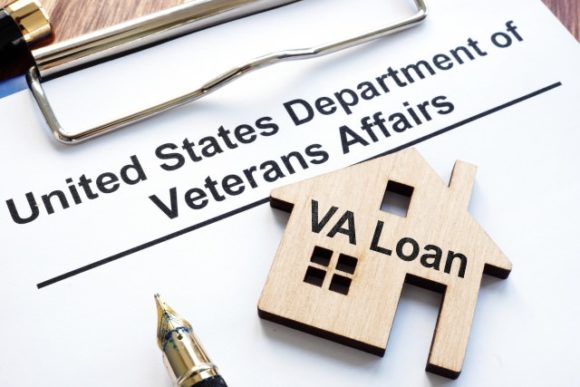If you’re a veteran or active-duty military, VA home loans are one of the best mortgage financing deals available.
But did you know the VA also offers rehab loans, enabling you to purchase a “handyman special” at a lower price and convert it into the property of your dreams?
The addition of VA rehab loans makes the whole VA home loan program even more attractive.
VA rehab loans aren’t a separate loan program.
Since they add an additional dimension to regular VA home loans, let’s start by discussing the basics of VA home loans, then delve into rehab loans.
How Renovation Loans Compare To Standard VA Loans
Regular VA home loans provide eligible active-duty military personnel and veterans with the advantage of 100% financing.
Loans are available for one-to-four, family owner-occupied properties, and not for vacation homes or investment properties.
VA Funding Fee
Another major advantage is in the area of private mortgage insurance.
Both conventional and FHA mortgages require monthly premiums for this coverage, and it can be particularly steep on conventional loans with low credit scores.
But VA loans don’t require monthly mortgage insurance. Instead, they require a VA funding fee, which is added to the loan amount, and financed over the term of the mortgage.
Sample VA funding fee rates are as follows:
- VA Purchase or Construction Loan: 2.15% of the loan amount for first-time use, 3.3% for subsequent uses.
- VA Cash-out Refinance: 2.15% for first-time use, 3.3% for subsequent uses.
- Interest Rate Reduction Refinance Loan (IRRRLs): 0.5%, regardless of equity.
VA Loan Limits
You can borrow up to $726,200 for a single-family residence. But that amount increases to as much as $1,089,300 in areas considered to be high-cost housing areas. The higher loan amounts are based on the county where the property is located.
Limits for 2-4 family properties are as follows:
- Two units, $828,700 (up to $1,243,050 in high-cost areas)
- Three units, $1,001,650 (up to $1,502,475 in high-cost areas)
- Four units, $1,244,850 (up to $1,867,275 in high-cost areas)

You can also exceed those loan limits through VA jumbo loans. You’ll need to qualify for the higher loan amounts based on your income, and you should expect to make a down payment.
Borrower Requirements for VA Home Loans
Credit and income requirements for VA home loans are as follows:
Credit. VA loans don’t have a minimum credit score requirement, but you do need to have clean credit for at least the past 12 months.
This applies especially to either your rent or current mortgage payment. However, individual lenders can impose their own credit score minimums.
Where this is the case, the minimum is sometimes as low as 580, but more typically 620.
If you had a chapter 7 bankruptcy or a foreclosure, you must have at least two years of clean credit to be eligible for a VA home loan. But if the foreclosure involved another VA loan, the waiting period is three years.
Income qualifications. All lenders determine income eligibility based on what’s known as a debt-to-income ratio (DTI). This is the proposed house payment on the new mortgage, plus any recurring monthly debts.
For example, if you have a stable monthly income of $5,000, a new monthly house payment of $1,500, and other recurring monthly debts of $500, your DTI will be 40% ($2,000 divided by $5,000).
The VA has an official DTI limit of 41%, but lenders will often go as high as 50% if you have strong compensating factors, like excellent credit.
But unlike conventional and FHA mortgages, VA loans also make use of a second income qualification, referred to as the residual income method.
It works by taking your stable monthly income, then subtracting your new house payment, recurring debt payments, and typical living expenses (utilities, income taxes, and insurance).
The amount leftover – or residual balance – should be sufficient to cover an allowance based on your household family size. But generally, if you meet the DTI ratio, you’ll also meet the residual income requirement.
VA Loan Rates
VA Rehab Loans
All the above requirements and guidelines that apply to regular VA home loans also apply to VA rehab loans.
The main difference is that VA rehab loans enable you to purchase a property while providing the financing necessary to make any required renovations.
While regular VA home loans are for the purchase of properties that are ready to move into, VA rehab loans are designed with the fixer-upper in mind.
This can be an important advantage in high-priced markets, where “turnkey” properties are priced out of reach, even for veterans with 100% financing available.
Buying a house that needs some elbow grease can enable veterans to buy a property that’s much more affordable.
Using a VA rehab loan, the veteran can not only get the needed funds to purchase the property, but to also make necessary improvements.
In more typical cases involving property renovations, buyers will have to pay all cash for the purchase, then either come up with additional funds for the repairs or secure another source of financing.
The Basics of VA Rehab Loans
VA rehab loans are available for both eligible VA purchases and refinances.
In the case of purchases, a house must meet the VA’s minimum property requirements for safety and livability. But with a rehab loan, you can use the proceeds of the loan to bring the property up to those minimum standards.
Completing required renovations. One of the complications of a rehab loan is that you have to work with a VA registered contractor or builder to complete the repairs. That is, you won’t be able to buy a property using a VA rehab loan and perform the repairs yourself.
The lender will act as the overseer of the project. They’ll monitor the progress of the renovation work to make sure it’s consistent with the rehab plans.
The lender will ensure that the project is completed according to the plans, specifications, and contract documents.
Funds are disbursed as progress is verified and approved by the veteran. Disbursement of funds for rehab costs will be paid out of a draw account established by the lender.
Applying for VA Rehab Loans
Once you select a property, it’s time to apply for a VA loan. You must work with a lender that participates in the VA rehab loan program – not all do. Also be aware that even if a lender participates, they may have a maximum dollar amount on the renovations.
For example, a particular lender may have a limit of $75,000 for total repair and renovation costs. If the property selected will need $95,000 in repairs, you’ll need to look for another lender.
The VA doesn’t impose a maximum renovation amount, so this can vary from one lender to another.
When applying for a VA rehab loan, you’ll be applying for two separate loans. The first will be for the purchase price of the home, based on the price specified in the contract.
The second will be for the cost of the renovations. Once the renovations are completed, the two loans will be rolled into a single mortgage with one monthly payment.
For that reason, you’ll have to have a plan – including projected costs – for the renovations to the property. This will need to be prepared by the VA approved contractor or builder.
Types of Rehab Loans
Types of repairs and renovations permitted include:
- Energy-efficient upgrades
- Replacement of the furnace, air conditioning, or other major home components
- Roof repair or replacement
- Floor repairs or replacement
- Repairs to the foundation of the home
- Repair or replacement of plumbing or electrical systems
Costs for the actual VA rehab loan are similar to those for a regular VA loan. However, while lenders typically charged a 1% origination fee on mortgage loans, they can charge up to an additional 2% as a construction fee.
This compensates the lender for the fact that it essentially manages the renovation project from the initial purchase of the property through completion of all repairs.
VA Rehab Loan Appraisals
Most mortgage lenders will require an appraisal to be performed on a property for just about any type of mortgage, including VA loans. But the necessary appraisals for VA rehab loans are more specialized.
The lender will order an appraisal on the property, to be performed by a VA appraiser.
The appraiser will provide a notice of valuation (NOV), that will estimate both the acquisition cost of the property and the as-completed value. We’ll go into the as-completed value in the next section, but concentrate on acquisition cost here.
The acquisition cost is the actual final price you’ll pay for the property, once all costs are factored in. Those costs include:
- The purchase price of the property,
- The total cost of anticipated renovations,
- A contingency reserve up to 15% of the renovation costs, and
- Fees for permits, inspections, and title updates.
The property will be considered 100% complete when a VA appraiser provides a final inspection.
The appraiser certifies all VA minimum property requirements have been met, and the house has been fully improved consistent with the original plans, specifications, approved change orders, and the as-completed value of the appraisal has been maintained.
Determining the Loan Value for VA Rehab Loans
The value the lender will use for loan purposes will be the lower of acquisition cost or the as-completed value. We just discussed how acquisition cost is calculated. But the as-completed value will represent the market value of the property after completion.
For example, let’s say the total acquisition cost of the property is $225,000, but the as-completed value – the price at which the property would likely sell – is $215,000.
The lender will base the value on the as-completed value, since it’s the lower of the two. Your maximum base loan amount then will be $215,000.
Turning the situation around, if the acquisition cost of the property is $235,000, but the as-completed value is $250,000, the base loan amount will be $235,000.
However, you’ll then be in the enviable position of owning a property worth $250,000, that cost you only $235,000 to buy and finance.
NOTE: If the acquisition cost is higher than the completed value, you’ll have to provide the additional funds at closing.
In the example given above, of an acquisition cost of $225,000 in a completed value of $215,000, you would need to come out of pocket with $10,000 to cover the difference.
This makes an important case for not over-improving the property, which is spending more on renovations than the final market value of the property can justify.
VA Rehab Loans for Refinances
If you want to make renovations to a property you already own, the process is similar to a purchase. However, the acquisition cost is calculated by adding the existing loan amount to the renovation costs, contingency reserve, and fees.
When the renovations are completed, the original mortgage is replaced by a new loan, that includes renovation costs.
But just as is the case with a purchase, the lender must use the lower of the acquisition cost or the as-completed value. So if the total acquisition cost is $150,000, but the as-completed value is $140,000, the maximum base loan amount will be $140,000. The remaining $10,000 in renovation costs will come out of your pocket.
(For complete details on VA rehab loans, see VA Loans for Alteration and Repair.)
Rehab vs. VA Loan: Which is best?
Probably the major factor separating VA home loans from VA rehab loans is the loan process itself.
It’s more complicated, because steps need to be taken to improve the property after the closing. Naturally, the more renovation work that’s required, the longer that process will be.
With a regular VA loan, you’ll close on the property, move in, and get on with your life. With VA rehab loans, you’ll close on the property, wait several weeks or months while renovations are being completed, then move into the home.
It’s a more formal process than what you will see on the typical property rehab programs on TV, where the buyers are doing their own repair work.
But since you’ll be using a builder or contractor to do the work, under the supervision of the lender, the renovation process should go more quickly.
If you’re a veteran, use a regular VA home loan for property that’s move-in ready. But if you want to save some money on the purchase price, buy a property that needs some TLC, and use a VA rehab loan to get the job done.

Equal Housing Opportunity. The Department of Veterans Affairs affirmatively administers the VA Home Loan Program by assuring that all Veterans are given an equal opportunity to buy homes with VA assistance. Federal law requires all VA Home Loan Program participants – builders, brokers, and lenders offering housing for sale with VA financing – must comply with Fair Housing Laws and may not discriminate based on the race, color, religion, sex, handicap, familial status, or national origin of the Veteran.




Comments:
About the comments on this site:
These responses are not provided or commissioned by the bank advertiser. Responses have not been reviewed, approved or otherwise endorsed by the bank advertiser. It is not the bank advertiser’s responsibility to ensure all posts and/or questions are answered.
Rachel Smith says
Hello!
Would you happen to have contact info on approved VA Rehab Loan Lenders? All I see are articles talking about them, but none of them tell me where I go for a VA Rehab loan lender. All I can find lenders who will do FHA 203(k) loans, but that doesn’t have the VA benefits along with the rehab loan. Thanks!
Thank you,
Rachel
Carl says
I agree, it means nothing if nobody will give us a loan for the VA Rehab I have looked and looked and nobody, I mean nobody offers this in NY it is a pathetic mess and only proves the overall failure by the VA to assist Veterans in securing this type of loan. like dangling a carrot in front of a rabbit.
Chad Champneys says
Hey there, a potential lender advised me that rates are higher for the VA Renovation loans due to the extended time period prior to closing.
Is this true?
She also mentioned that the home must be habitable, where here you say you can go weeks without moving in.
Who is correct?
Juan Bloomer says
Hello Ryan,
I hope you’re well.
Thanks a lot for this. Very informative piece.
Would you happen to have contact info on approved VA Rehab Loan Lenders and approved VA contractors in the Houston Area? Thanks!
All the Best,
J. Bloomer
Randall Williams says
If I wanted to buy a duplex that needs renovations on both sides so I can live in one side and rent the other out, will the VA Rehab Loan cover the expenses for the entire dwelling? Or only the side I plan on occupying? Also, when do your mortgage payments start? On closing? Or when the house is in livable condition and approved by the VA?
Ryan Guina says
Hello Randall, If you buy the entire unit, the VA rehab loan would cover the entire dwelling. I believe the mortgage payments will start when you take out the loan and make the purchase, not when the unit is in livable condition. The bank processes the loan so the borrower can make the purchase. Once the borrower takes out the loan, they must begin making payments.
That said, the best way to work through this process is with a qualified lender. They can help you understand the process and see if you qualify for the loan.
I wish you the best, and thank you for your service.